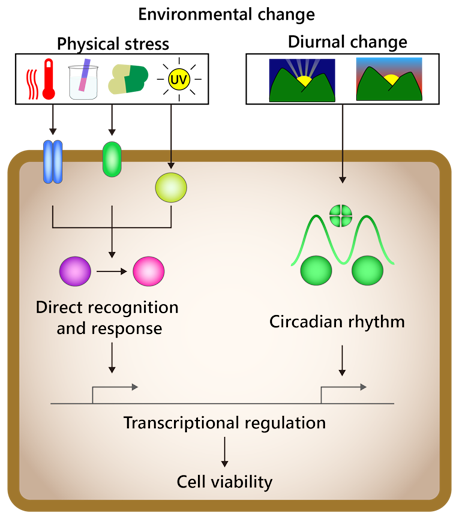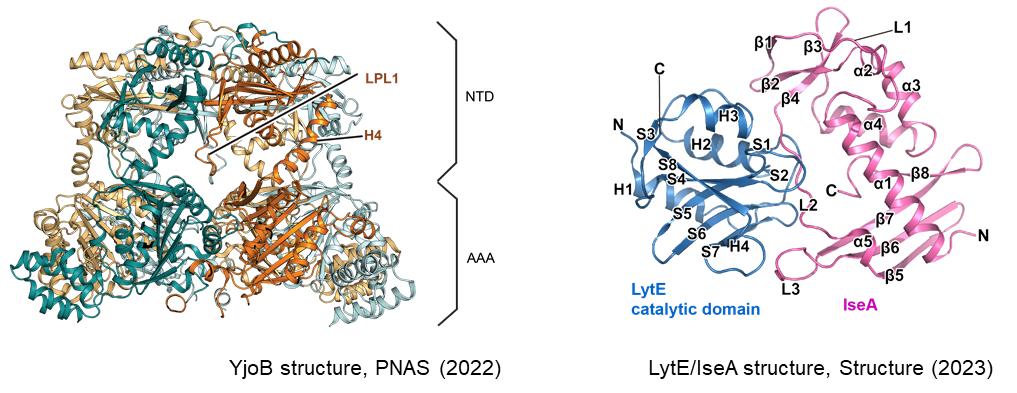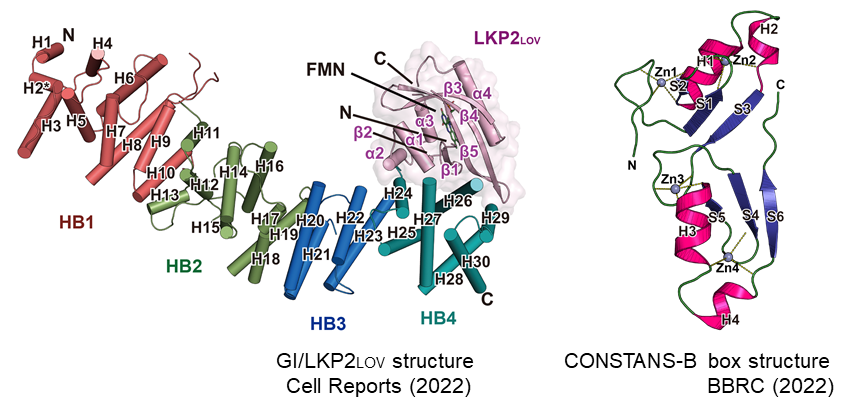1. Structural and functional studies of cellular stress response system
All living organisms recognize environmental changes and adapt to the changed conditions. In order to survive in harsh environments, the cells change gene expression patterns in response to the changed environment and consequently reprogram protein expression patterns. For example, cells directly recognize heat shock and oxidation and increase the expression of genes capable of counteracting the stress (Figure, left). In addition to directly recognizing environmental factors, most eukaryotic cells adapt to the external environment with an intrinsically oscillating circadian rhythm. These circadian rhythms regulate gene expression in the day-night cycle and consequently help cells adapt to repetitive diurnal changes (Figure, right). Notably, plants use a complex circadian control system to regulate overall plant physiology, such as germination and flowering, as well as adaptation to day and night environments. Thus, cells may lose their ability to adapt to the changed environment when the environmental response system is not properly working. In these circumstances, bacteria may become vulnerable to heat, oxidation, and antibiotics under the dysfunction of the system, and plants may lose resistance to high temperatures, drought, and high salinity and control over germination and flowering. Contrary to this, cells can have an enhanced ability for environmental adaptation when the response system is properly controlled.
The modern world is facing new environmental changes such as climate, overuse of antibiotics, and the emergence of new viruses. These environmental changes not only affect the viability of humans themselves but also become factors that threaten human survival, such as reduced crop production, the emergence of super-bacteria, and viral pandemics. To overcome environmental threats, it is necessary to accurately understand the cellular stress-response system. In this regard, the structural biology lab studies the stress-response system of bacteria and plants.

a. Structural and functional studies of the bacterial stress-response system
Since bacteria grow in a harsh environment where temperature and nutritional status change rapidly, they have to respond quickly to environmental changes for survival by changing protein expression patterns. Overall gene expression patterns in bacteria are regulated mainly by sigma factors. Bacteria have multiple sigma factors, each responding to specific stress and changing gene expression patterns to counteract the stress. In addition to the regulation of overall gene expression, the expression of specific genes is regulated in operon units in response to specific signals. Although understanding the bacterial stress response and gene expression regulation has been enhanced over the last few decades, the fundamental action mechanism at the protein biochemistry level has yet to be studied much in most cases. Especially, it is unclear how the bacteria recognize stress and activate the expression of stress-response genes and how the stress-response genes counteract the stress. To further understand the mechanisms, we analyze the protein-protein interaction, complex structures, and biochemical functions of bacterial stress response proteins.

b. The structural understanding of the plant circadian clock system
Since plants cannot move as sedentary organisms, they are directly exposed to environmental stress, such as changes in temperature and photoperiod, high salinity, and drought. Plants possess a different stress resistance system than animals to adapt to various environmental changes. In particular, plants have complex circadian clock control systems that can recognize temperature and seasonal photoperiod. The circadian clock system enables plants to adapt to day and night environmental changes and regulate overall physiology, including germination and flowering. To understand the regulatory principles of the plant circadian clock system, we analyze the protein-protein interaction, complex structures, and biochemical functions of plant circadian clock proteins.

2. Protein engineering and pharmaceutical application
Proteins fold into tertiary structures and form larger quaternary structures through protein-protein interactions. This allows each protein to have a distinct function and structure. Due to these properties, proteins can be used to control substances at a molecular level. Recent advancements in protein design and structure prediction have enabled the making of new proteins for industrial use. We are currently working to apply our accumulated experience in protein engineering to the pharmaceutics field.

